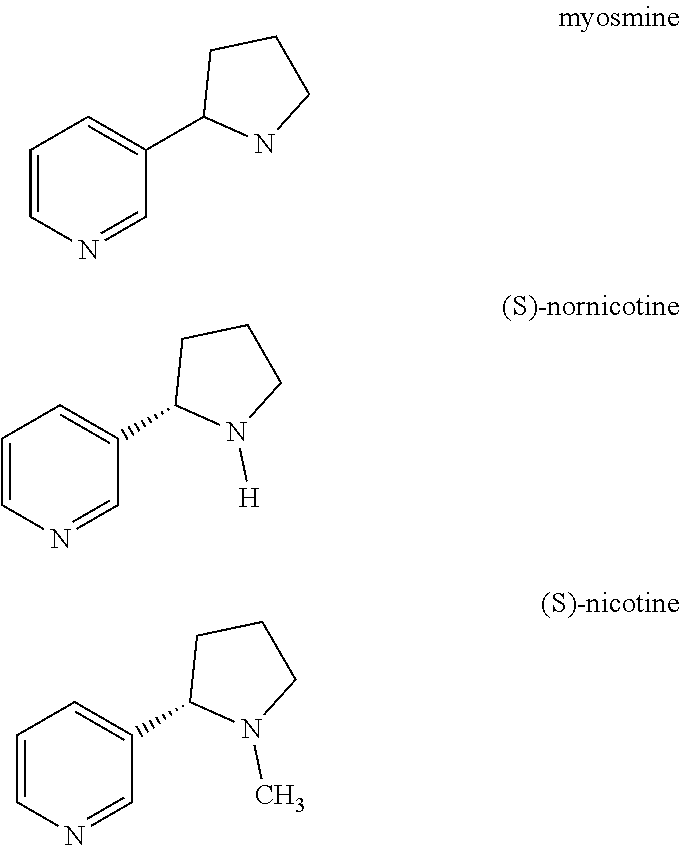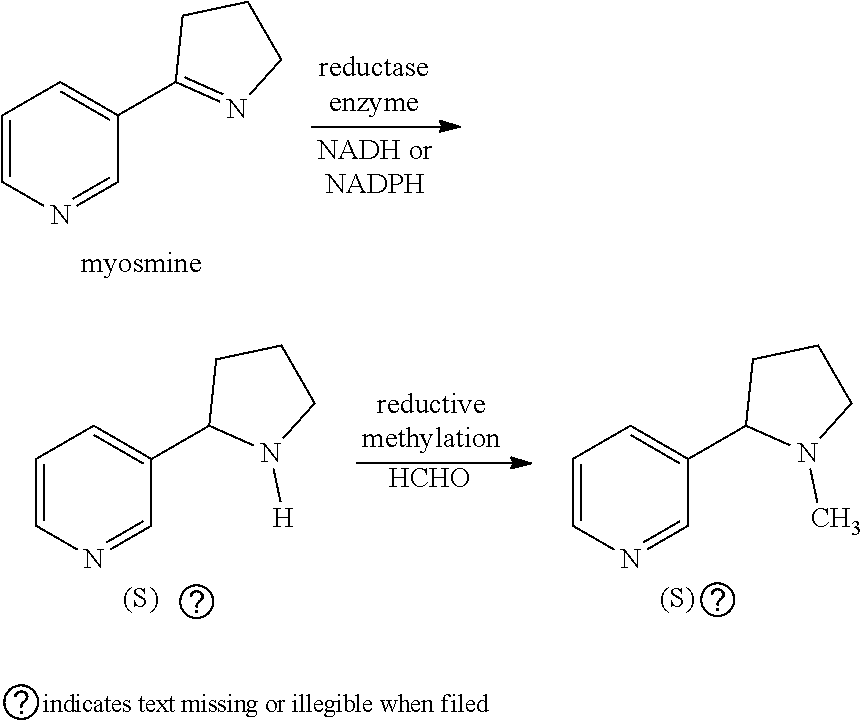Process
a technology of process and enantiomeric, applied in the field of process, can solve the problems of difficult removal, difficult to harmful carcinogenic effects, and achieve high chemical purity, high enantiomeric and chemical purity, and high chemical purity.
- Summary
- Abstract
- Description
- Claims
- Application Information
AI Technical Summary
Benefits of technology
Problems solved by technology
Method used
Image
Examples
example 1
[0054]Biotransformations were undertaken at 0.5 mL scale with a solution of 10 mM myosmine and NADP+(0.5 mM), glucose (25 mM), glucose dehydrogenase (10 U / ml ), and the enzyme with imine reductase activity. The enzymes used are detailed in table 1, available from Enzymicals. For each enzyme, the amount of enzyme was 9 mg / ml of cell free extract (estimated approx. 0.9 mg / ml contained enzyme). For IRED_B and IRED_C specifically, additional tests were run which used 0.9 mg / ml cell free extract.
[0055]The enantiomeric excess of the (S) nornicotine obtained from the biotransformation was determined using a Chiralpak AD-H column (250×4.6 mm id) eluting with a mixture of hexane:ethanol:diethylamine 74.9 : 25.0: 0.1 (v / v / v) at 1 ml / min over 18 min at 30° C. This method was also used to measure the conversion of myosmine into nornicotine, a relative response factor of 2.18 : 1 having been determined for uv absorption detection at 254 nm.
[0056]The results are displayed in table 1 below.
TABLE 1...
example 2
[0058]Reactions were carried out in a similar manner to that of example 1, except that 1.5 equivs glucose and 1 mol % NADP+were used relative to the myosmine substrate, and a 24 hr reaction time was employed. The enzymes used are detailed in each of tables 2, 3 and 4 (available from Enzymicals).
[0059]At 100 mM myosmine concentration, using 0.9 mg / mL enzyme cell free extract, the results were as displayed in the table below:
TABLE 2ConversionEnantiomericEnzyme[A]Excess [% S]iIRED_A63.699.8iiIRED_B99.998.7iiiIRED_C99.999.8ivIRED_D99.099.9vIRED_E99.999.9
[0060]At 100mM myosmine concentration, using 9mg / mL enzyme cell free extract, the results were as displayed in the table below:
TABLE 3ConversionEnantiomericEnzyme[A]Excess [% S]iIRED_A99.999.8iiIRED_B99.898.8iiiIRED_C99.899.9ivIRED_D99.9100.0vIRED_E99.999.9
At 250 mM myosmine concentration, using 9 mg / mL enzyme cell free extract, the results were as displayed in the table below:
TABLE 4ConversionEnantiomericEnzyme[A]Excess [% S]iIRED_A100....
example 3
[0061]A solution of myosmine (20 mmol, 2.924 g), D-Glucose (30 mmol, 5.405 g) nicotinamide adenine dinucleotide phosphate sodium salt (0.2 mmol, 157 mg), enzyme IRED_A (available from Enzymicals) cell free extract lyophilizate (1.0 g), glucose dehydrogenase (2000 U, 40 mg) in pH7.5 100 mM sodium phosphate buffer (200 mL) was mixed by an overhead stirrer at 200 rpm at 30° C. for 24 hours. The solution was analysed for nornicotine during the course of the reaction with HPLC showing 77% conversion after 8 hours, and over 99% conversion after 24 h with 98.7% e.e. (S)-Nornicotine. This solution was then treated with 37% formaldehyde solution (8.1 g) and formic acid (2.8 g) at 80° C. for 4 h, with the reaction being complete after 2 h. After cooling, 6 g solid sodium hydroxide was added (pH 12.7) and the mixture extracted with 2×75 ml MTBE. After drying over sodium sulphate, the solvent was removed to afford 2.25 g crude (S)-nicotine which was >99% pure by HPLC (area % at 260 nm) and had ...
PUM
| Property | Measurement | Unit |
|---|---|---|
| enantiomeric excess | aaaaa | aaaaa |
| enantiomeric excess | aaaaa | aaaaa |
| enantiomeric excess | aaaaa | aaaaa |
Abstract
Description
Claims
Application Information
 Login to View More
Login to View More - R&D
- Intellectual Property
- Life Sciences
- Materials
- Tech Scout
- Unparalleled Data Quality
- Higher Quality Content
- 60% Fewer Hallucinations
Browse by: Latest US Patents, China's latest patents, Technical Efficacy Thesaurus, Application Domain, Technology Topic, Popular Technical Reports.
© 2025 PatSnap. All rights reserved.Legal|Privacy policy|Modern Slavery Act Transparency Statement|Sitemap|About US| Contact US: help@patsnap.com


